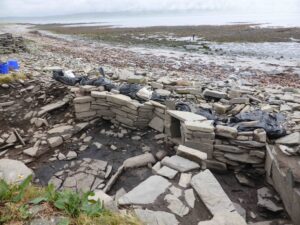
One of the curious things about archaeology is that, while it is relatively easy to see the fruits of our labours, it is much harder for people to watch us at work. Most people live within reach of a stone circle, castle, or other archaeological site. Getting to visit an excavation is another matter, especially in these days of commercial contracts. Hence the popularity when it first opened of the Jorvik DIG centre and of television programmes like Time Team.
Here in Orkney, visitors are spoilt for choice. The archaeological sites here are well-known and a popular draw for tourists. Should you be visiting this summer, you also have a choice of nine excavations to visit. All within an area of 990 km² (according to Google), and all visitor-friendly. Most have Open Days. Not only that – the work covers a range of periods from Neolithic, through Iron Age to Medieval. Truly something for everyone.
Of course, the big site, and one whose global reach draws in visitors from far afield, is Ness of Brodgar in Mainland Orkney. Only discovered in 2003, excavation of the monumental buildings, highly decorated pottery and other finds here is revealing a hitherto unimagined side to Neolithic Orkney. There are regular tours and Open Days as well as a daily blog. To the south, in South Ronaldsay, the excavation of the broch and associated structures at The Cairns has just ended. Work this year focussed on the well at the heart of the broch where organic preservation revealed a complete wooden bowl as well as other rare Iron Age material. In Kirkwall, over the weekend of 29 – 30th June, test pitting in the grounds of 54 Victoria Street, at the Blide Trust, allowed a group of community volunteers to try their hand at archaeology and uncover some of the Medieval and more recent history of the site.
In the island of Rousay, there have been two excavation projects. At Skaill farmstead a team from The University of the Highlands and Islands Archaeology Institute are investigating the nineteenth century and early history of the ruins that mark a once-thriving settlement. Their finds suggest that the site goes back at least to the Norse period. Further along the coast a team from the University of Bradford are excavating the multi-period site of Swandro before it drops into the sea. The buildings here date from the Neolithic, Iron Age, Pictish and Norse periods, and it is no easy task to untangle the complex history of the site, but sadly coastal erosion is an ever-present threat to much of the archaeology of the islands.
Over in the island of Sanday, archaeologists from the University of Central Lancashire have teamed up with The University of the Highlands and Islands Archaeology Institute to research three of the island sites, dating to the Neolithic and Bronze Age. The digs on the Early Neolithic houses at Cata Sand, the Burnt Mound at Loth Road, and the Neolithic Tomb at Tresness have each, in their own way, revealed surprises – that is what makes archaeology such fun! You can never predict the outcome. I’m not sure why the diversity and complexity of the remains of the past continue to amaze us, but they do.
Finally, in Westray, the furthest north of the sites, lies Links of Noltland where excavation on an extensive Neolithic settlement site has been ongoing, intermittently, since the late 1970s. I have a soft spot for this site, because, although it was visited by George Petrie in the nineteenth century, it had fallen out of sight and so I was lucky enough to be tasked by the National Museum of Scotland, to look for it not long after I graduated in 1977. It is a wonderful place to visit, an opportunity to get up close to well-preserved Skara Brae type houses as they emerge from the sands of the beach at Grobust.
This focus of practical investigation on Orkney is, it seems to me, remarkable, and it brings both advantages and disadvantages. Of course, the uncovering of the rich history of the islands is to be welcomed. And it is great to see research on lesser known periods such as Medieval Orkney and the nineteenth century. But, one has to ask whether it can, sometimes, shift attention away from equally deserving parts of Scotland. Even if we can be sure that other areas receive equal investigation, there is the possibility that the so-called ‘special’ archaeology of Orkney is merely an artefact of our own making. By concentrating our efforts in the north, have we created the impression that archaeology there is ‘better’ than that to be found elsewhere? In reality the lives of the people of the past in other parts of Scotland are no less well-preserved, less interesting, or less well-deserving. The so-called primacy of Orkney has long been debated, and provides the basis for a favourite essay or exam question to set one’s students.
Setting such introspection aside, I do love working as an archaeologist in Orkney. There are so many archaeologists here that you might think that we would all be jostling for work, but in reality, there is plenty to keep us busy, and weeks can pass without bumping onto one another. There is always room for more. When I lived in Edinburgh no one quite knew what I did for a living. Here, being an archaeologist is commonplace. Most people are well informed and interested – you see friends at lectures, and get into erudite conversations at the supermarket checkout.
It is the way it should be: archaeology is valued and respected, yet unexceptional. A familiar part of everyday life.
You must be logged in to post a comment.